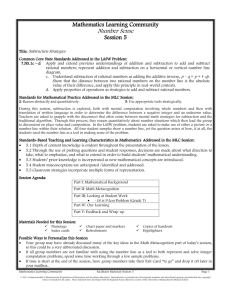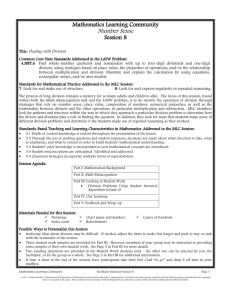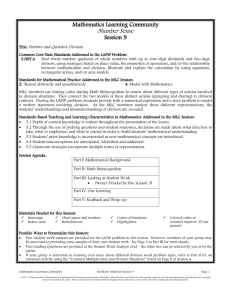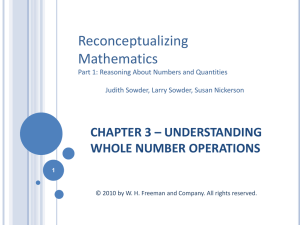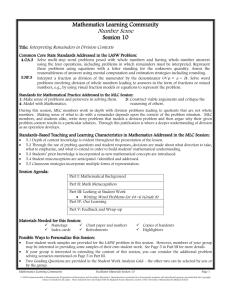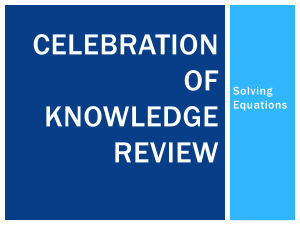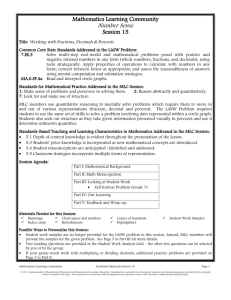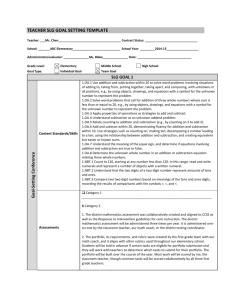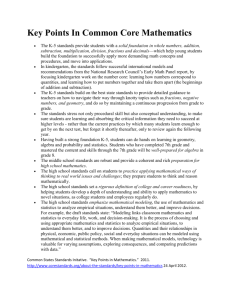Mathematics Learning Community
advertisement
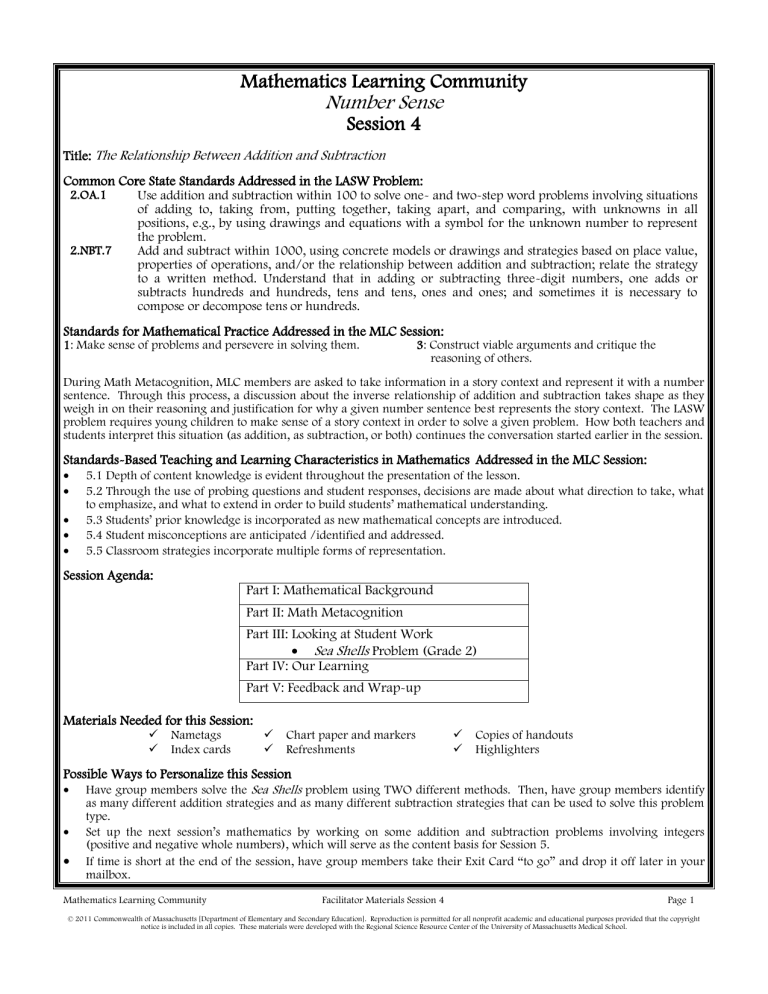
Mathematics Learning Community Number Sense Session 4 Title: The Relationship Between Addition and Subtraction Common Core State Standards Addressed in the LASW Problem: 2.OA.1 Use addition and subtraction within 100 to solve one- and two-step word problems involving situations of adding to, taking from, putting together, taking apart, and comparing, with unknowns in all positions, e.g., by using drawings and equations with a symbol for the unknown number to represent the problem. 2.NBT.7 Add and subtract within 1000, using concrete models or drawings and strategies based on place value, properties of operations, and/or the relationship between addition and subtraction; relate the strategy to a written method. Understand that in adding or subtracting three-digit numbers, one adds or subtracts hundreds and hundreds, tens and tens, ones and ones; and sometimes it is necessary to compose or decompose tens or hundreds. Standards for Mathematical Practice Addressed in the MLC Session: 1: Make sense of problems and persevere in solving them. 3: Construct viable arguments and critique the reasoning of others. During Math Metacognition, MLC members are asked to take information in a story context and represent it with a number sentence. Through this process, a discussion about the inverse relationship of addition and subtraction takes shape as they weigh in on their reasoning and justification for why a given number sentence best represents the story context. The LASW problem requires young children to make sense of a story context in order to solve a given problem. How both teachers and students interpret this situation (as addition, as subtraction, or both) continues the conversation started earlier in the session. Standards-Based Teaching and Learning Characteristics in Mathematics Addressed in the MLC Session: 5.1 Depth of content knowledge is evident throughout the presentation of the lesson. 5.2 Through the use of probing questions and student responses, decisions are made about what direction to take, what to emphasize, and what to extend in order to build students’ mathematical understanding. 5.3 Students’ prior knowledge is incorporated as new mathematical concepts are introduced. 5.4 Student misconceptions are anticipated /identified and addressed. 5.5 Classroom strategies incorporate multiple forms of representation. Session Agenda: Part I: Mathematical Background Part II: Math Metacognition Part III: Looking at Student Work Sea Shells Problem (Grade 2) Part IV: Our Learning Part V: Feedback and Wrap-up Materials Needed for this Session: Nametags Index cards Chart paper and markers Refreshments Copies of handouts Highlighters Possible Ways to Personalize this Session Have group members solve the Sea Shells problem using TWO different methods. Then, have group members identify as many different addition strategies and as many different subtraction strategies that can be used to solve this problem type. Set up the next session’s mathematics by working on some addition and subtraction problems involving integers (positive and negative whole numbers), which will serve as the content basis for Session 5. If time is short at the end of the session, have group members take their Exit Card “to go” and drop it off later in your mailbox. Mathematics Learning Community Facilitator Materials Session 4 Page 1 © 2011 Commonwealth of Massachusetts [Department of Elementary and Secondary Education]. Reproduction is permitted for all nonprofit academic and educational purposes provided that the copyright notice is included in all copies. These materials were developed with the Regional Science Resource Center of the University of Massachusetts Medical School. Part I: Mathematical Background Approximate Time: 20 minutes Grouping: Whole Group A. Welcome members of your group to the Math Learning Community. B. Remind group of established norms. C. Today’s Content: a. The mathematics during this session focuses on addition and subtraction and how the two operations are related. b. What is subtraction? How is it similar to addition? How is it different? c. What do we need to know about this relationship in order to be able to subtract? d. Chart ideas to refer to during the Protocol for LASW. e. How can you use your understanding of addition as a joining operation to make sense of subtraction as a removal, comparison, or distance operation? f. It is important to use or refer to multiple models of subtraction. Students should have experiences in subtraction other than the “take away” model. Additional models to consider are comparison and distance. D. Relating Content to the Three C’s Theme: a. The relationship between addition and subtraction presents the same idea about decomposing a whole into quantities. It is important to understand how to put things together or how things go together before you can understand taking things apart. Mathematics Learning Community Facilitator Materials Session 4 Page 2 © 2011 Commonwealth of Massachusetts [Department of Elementary and Secondary Education]. Reproduction is permitted for all nonprofit academic and educational purposes provided that the copyright notice is included in all copies. These materials were developed with the Regional Science Resource Center of the University of Massachusetts Medical School. Part II: Math Metacognition Approximate Time: 25 minutes Grouping: Whole Group A. Present the group with the following problem, on chart paper or on the board. After time is given for group members to think about each problem individually, elicit solutions from the group and chart them to refer to during future sessions. Represent each of the following as a number sentence: A. Sandy has 43 flowers in her garden. 25 are red, the rest are yellow. How many are yellow? B. I have some crayons. I gave 13 to Beth. Now I have 38. How many crayons did I start with? B. Solutions: a. 43 – 25 = y b. c – 13 = 38 43 = 25 + y 13 + 38 = c C. Problem Intent: (NOTE: The problem intent for all Math Metacognition is the same). See Session 2 for more information. D. Discuss how each group member thought of representing the problems with number sentences. a. If time allows, consider other ways to rewrite each number sentence. Use number properties and integers as you rewrite the number sentences to justify your thinking. Write a new corresponding story problem for each number sentence. E. Describe how the two story problems are alike and different. Mathematics Learning Community Facilitator Materials Session 4 Page 3 © 2011 Commonwealth of Massachusetts [Department of Elementary and Secondary Education]. Reproduction is permitted for all nonprofit academic and educational purposes provided that the copyright notice is included in all copies. These materials were developed with the Regional Science Resource Center of the University of Massachusetts Medical School. Part III: Looking at Student Work (LASW) Approximate Time: 50 minutes Grouping: Refer to protocol A. Problem Introduction: The problem and student work used for this session are from Grade 2. Complete the MLC Protocol with the group. B. Sea Shells Problem: Jackie and Sara collected shells at the beach. Jackie collected 48 shells in all. She collected 13 more shells than Sara. How many shells did Sara collect? C. Solution: 35 shells. D. Problem Intent: The intent of this problem is to see if MLC members can identify and notate various addition and subtraction strategies and understand the relationship between different algorithms and how students understand and can work with numbers. (Note: the problem in the next session will explore similar thinking but at a higher grade level – with subtraction of integers). This conversation will be continued as you explore what is the same and different with integer subtraction. E. Strategies You Might See: a. See Page 5 for a listing of possible strategies. b. Both addition and subtraction strategies can be used to solve this problem. F. Misconceptions & Questions That May Arise: a. M: Many students use drawings both as a problem solving strategy and as a means to justify a problem solution. However, using a drawing involving a large quantity of items can often lead to errors and an incorrect solution. When are drawings not appropriate in a problem solving situation? b. M: Many students see words such as “in all” and “more” and automatically think addition, especially if instruction in ‘key words’ has been given. Students end up blindly operating on numbers and fail to ask themselves: “What is the problem asking me to find out?” c. Q: Discuss strategies for comparing a problem situation involving 48 and 13. What strategy is the student using to compare those two quantities? d. Q: Representations (i.e., number sentence and story problem) may not match – what does this tell you about the student’s understanding? e. Q: How are the students able to compose/decompose numbers and how does that influence the strategy they use to solve the problem? Mathematics Learning Community Facilitator Materials Session 4 Page 4 © 2011 Commonwealth of Massachusetts [Department of Elementary and Secondary Education]. Reproduction is permitted for all nonprofit academic and educational purposes provided that the copyright notice is included in all copies. These materials were developed with the Regional Science Resource Center of the University of Massachusetts Medical School. Sea Shells Problem Possible Strategies Removing what’s in common and identifying what’s left over (making an equivalent problem) 48 – 13 = (10 + 10 + 10 + 10 + 5 + 3) – (10 + 3) (10 + 10 + 10 + 10 + 5 + 3) – (10 + 3) = 35 Counting up 13 + 10 = 23 23 + 20 = 43 43 + 5 = 48 10 + 20 + 5 = 35 Subtracting by place and adding differences 8-3=5 40 – 10 = 30 30 + 5 = 35 Keeping the distance between the two numbers the same (making an equivalent problem) 48+ 2 = 50 13 + 2 = 15 50 – 15 = 35 Subtracting one number in parts from the other (13 = 10 + 3) 48 – 10 = 38 38 – 3 = 35 Number Line Model 35 36 37 38 13 14 15 25 35 48 45 46 47 48 Changing one number and compensating for the change 48 + 2 = 50 50 - 13 = 37 37 – 2 = 35 Mathematics Learning Community Facilitator Materials Session 4 Page 5 © 2011 Commonwealth of Massachusetts [Department of Elementary and Secondary Education]. Reproduction is permitted for all nonprofit academic and educational purposes provided that the copyright notice is included in all copies. These materials were developed with the Regional Science Resource Center of the University of Massachusetts Medical School. Part IV: Our Learning Approximate Time: 20 Minutes Grouping: Whole Group A. Discussion: After evidence of student understanding has been discussed as a whole group, you want to facilitate discussion around how the LASW process will impact what teachers do within their classrooms. Some questions to help guide discussion include: a. What do we take away after LASW? b. What did we learn? About student thinking? About our own knowledge? i. Refer back to chart made at the beginning of the session c. How does today’s session relate to important mathematical content and pedagogy? d. How does it impact my practice at my grade level? (Note: In order to help teachers connect this session to the mathematics within their own grade level refer to the information below). Making Connections Across the Grade Levels K – 2: The LASW problem is adapted from a Grade 2 curriculum and specifically addresses 2.OA.1 and 2.NBT.7. The addition and subtraction strategies, along with the exploration of the relationship between them, are taught during this grade band (K.OA.1, K.OA.2, K.OA.5, 1.OA.1, 1.OA.2, 1.OA.3, 1.OA.4, 1.OA.5, 1.OA.6, 1.OA.8, MA.1.OA.9, 2.OA.2, 2.OA.4, 2.NBT.6, 2.NBT.7, 2.NBT.8, 2.NBT.9). 3 – 5: Just as students in K – 2 explore the unique relationship between the operations of addition and subtraction, students in upper elementary school explore the inverse relationship between multiplication and division in addition to the relationship with addition and subtraction with greater numbers and with decimals (3.OA.7, 3.NBT.2, 4.NBT.6, 5.NBT.6, 5.NBT.7) 6 – 8: All properties of operations (+, - , x, ÷) learned throughout Grades K – 5 are once again revisited as students are introduced to integers (positive and negative whole numbers). Included in this exploration is the very important idea of additive and multiplicative inverses, which serve as a foundation for understanding integer computation (7.NS.1 a – d, 7.NS.2 a – d). B. Writing a Problem or a Task: As a way to synthesize learning from today’s session, ask MLC members to come up with a math problem or task that would embody the ideas discussed today. The problem should be appropriate to use at their grade level. Writing these problems will help both you as the facilitator and the other group members to develop a stronger sense of how these mathematical ideas show up in classrooms from grades K – 8. (Note: See Part IV in Session 1 for more details). Mathematics Learning Community Facilitator Materials Session 4 Page 6 © 2011 Commonwealth of Massachusetts [Department of Elementary and Secondary Education]. Reproduction is permitted for all nonprofit academic and educational purposes provided that the copyright notice is included in all copies. These materials were developed with the Regional Science Resource Center of the University of Massachusetts Medical School. Part V: Feedback & Wrap-up Approximate Time: 5 Minutes Grouping: Individual A. Closing: Close the session with a message such as: “Hope you leave here with more questions – about student thinking, about your teaching, and ways that we as a group can help support one another.” Have MLC members keep in mind the following: Dialogue, Reflection, and Inquiry are the keys to successful learning. B. Exit Cards: Pass out exit cards for group members and ask them to provide some feedback to you as the facilitator. Select one or two questions from the list below to help them summarize their thinking about the mathematics from today’s session. Collect exit cards so that a summary can be shared at the next session. Feedback / Exit Card Questions How does the mathematics that we explored connect to your own teaching? How do I see what we’ve done today relate to key mathematical ideas or pedagogical content knowledge? What idea or discussion topic did you find most interesting from today’s session. Why? How was this session for you as a learner? What ideas were highlighted for you in today’s session that you had not previously considered? What are you taking away from today’s session? Related Student Discourse Video Clips – LASW Problem Bridges to Classroom Mathematics, Segment #1: Grade 2 Subtraction Problem: 63 - ? = 37 Developing Mathematical Ideas: BST, Session 2 Video: Subtraction Students: Naillil / Becky Relearning to Teach Arithmetic, Session 3, Tape 1 Student: Naillil Session References Bridges to Classroom Mathematics, TERC/COMAP, 1998 Developing Mathematical Ideas: “Number and Operations, Part 1: Building a System of Tens,” by D. Schifter, V. Bastable, and S. Russell, Dale Seymour Publications, 1999. Relearning to Teach Arithmetic: Addition and Subtraction Guide, Dale Seymour Publications, 1999. Mathematics Learning Community Facilitator Materials Session 4 Page 7 © 2011 Commonwealth of Massachusetts [Department of Elementary and Secondary Education]. Reproduction is permitted for all nonprofit academic and educational purposes provided that the copyright notice is included in all copies. These materials were developed with the Regional Science Resource Center of the University of Massachusetts Medical School. Math Metacognition Represent each of the following as a number sentence: A. Sandy has 43 flowers in her garden. 25 are red, the rest are yellow. How many are yellow? B. I have some crayons. I gave 13 to Beth. Now I have 38. How many crayons did I start with? Mathematics Learning Community Facilitator Materials Session 4 Page 8 © 2011 Commonwealth of Massachusetts [Department of Elementary and Secondary Education]. Reproduction is permitted for all nonprofit academic and educational purposes provided that the copyright notice is included in all copies. These materials were developed with the Regional Science Resource Center of the University of Massachusetts Medical School. LASW Problem Jackie and Sara collected shells at the beach. Jackie collected 48 shells in all. She collected 13 more shells than Sara. How many shells did Sara collect? Mathematics Learning Community Facilitator Materials Session 4 Page 9 © 2011 Commonwealth of Massachusetts [Department of Elementary and Secondary Education]. Reproduction is permitted for all nonprofit academic and educational purposes provided that the copyright notice is included in all copies. These materials were developed with the Regional Science Resource Center of the University of Massachusetts Medical School. Student Work Analysis Problem: Sea Shells Grade Level: 2 Student A Mathematics Learning Community Facilitator Materials Session 4 Page 10 © 2011 Commonwealth of Massachusetts [Department of Elementary and Secondary Education]. Reproduction is permitted for all nonprofit academic and educational purposes provided that the copyright notice is included in all copies. These materials were developed with the Regional Science Resource Center of the University of Massachusetts Medical School. Student Work Analysis Problem: Sea Shells Grade Level: 2 Student B Mathematics Learning Community Facilitator Materials Session 4 Page 11 © 2011 Commonwealth of Massachusetts [Department of Elementary and Secondary Education]. Reproduction is permitted for all nonprofit academic and educational purposes provided that the copyright notice is included in all copies. These materials were developed with the Regional Science Resource Center of the University of Massachusetts Medical School. Student Work Analysis Problem: Sea Shells Grade Level: 2 Student C Mathematics Learning Community Facilitator Materials Session 4 Page 12 © 2011 Commonwealth of Massachusetts [Department of Elementary and Secondary Education]. Reproduction is permitted for all nonprofit academic and educational purposes provided that the copyright notice is included in all copies. These materials were developed with the Regional Science Resource Center of the University of Massachusetts Medical School. Student Work Analysis Problem: Sea Shells Grade Level: 2 Student D Mathematics Learning Community Facilitator Materials Session 4 Page 13 © 2011 Commonwealth of Massachusetts [Department of Elementary and Secondary Education]. Reproduction is permitted for all nonprofit academic and educational purposes provided that the copyright notice is included in all copies. These materials were developed with the Regional Science Resource Center of the University of Massachusetts Medical School. Student Work Analysis for: Sea Shells Student What strategy does the student use to solve the problem? What evidence exists that the student understands the connection between the operations of addition and subtraction? If the student drew a picture, does the student use it to solve the problem or represent the solution? Do all representations match (pictures, numbers, words)? If not, what does this tell you about the student’s understanding? A B C D Mathematics Learning Community Facilitator Materials Session 4 Page 14 © 2011 Commonwealth of Massachusetts [Department of Elementary and Secondary Education]. Reproduction is permitted for all nonprofit academic and educational purposes provided that the copyright notice is included in all copies. These materials were developed with the Regional Science Resource Center of the University of Massachusetts Medical School.

